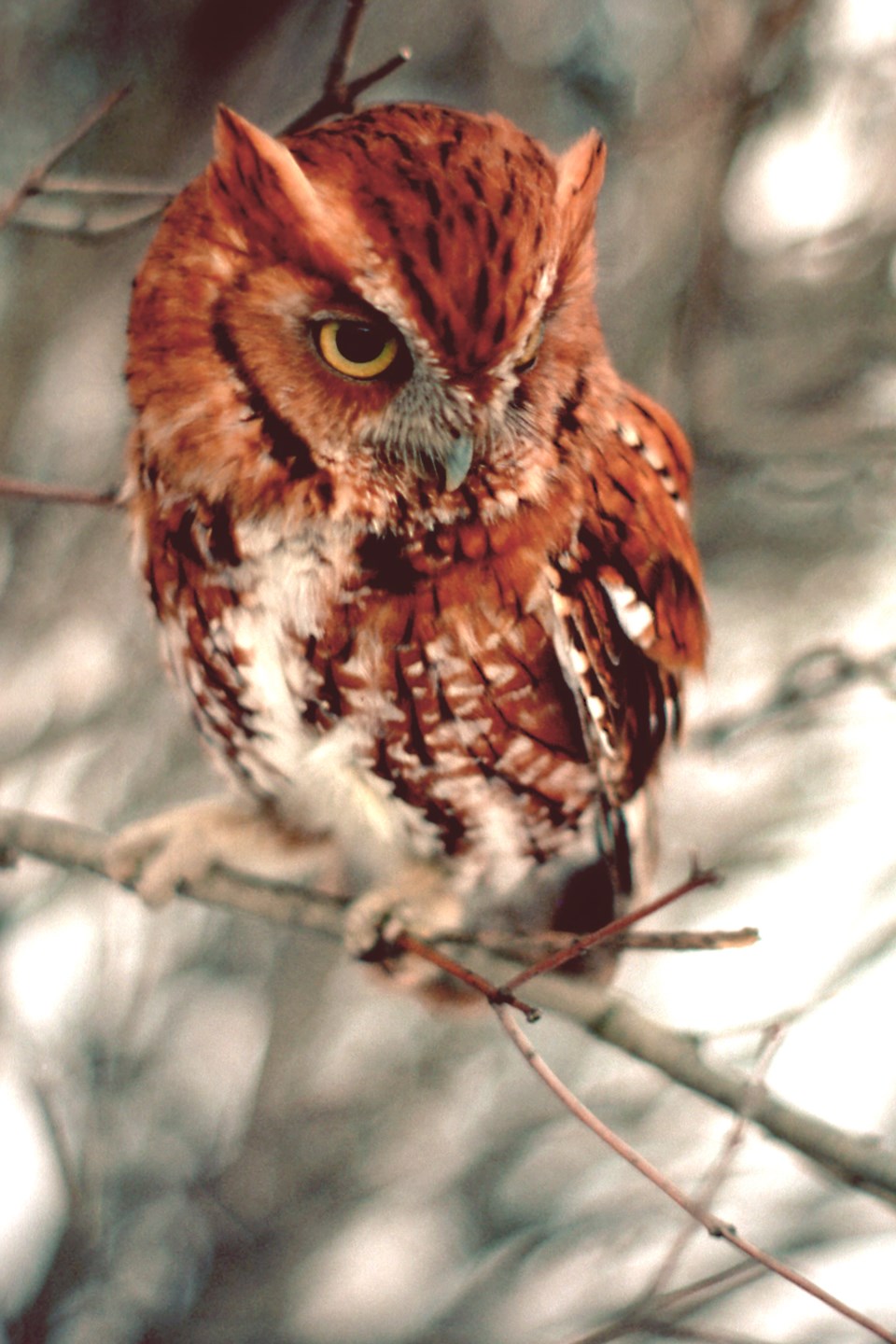As I peered out the window, taking a long-overdue break from staring at a computer screen, a lovely scene of natural wonderment was noted. A pair of chickadees scavenged through the hop vines, obviously seeking whatever morsel they missed yesterday, while a red-breasted nuthatch kept them close company. I could feel my eyes relax as I followed their antics.
In the background there stands a tall pole, and on the tall pole is placed a large wooden bird nesting box, and in the hole of this box there appeared something red. Not crimson red, but a rufous red, a browny red, with dabs of white and gray. And then it was gone, having dropped back down inside the box. Way cool, if what it was was what I thought it was!
And what it may well have been was a screech owl. These small owls stay with us year-round, although seldom seen. Two reasons that make them difficult to find are that they only come out at night to hunt, and spend all day sleeping inside a hollow tree or other cavity. If you've ever been called a 'night owl' then someone has mistaken you for a screech owl, maybe. Perhaps. Just sayin'.
However, on a sunny winter's day these owls fall victim to the same wants we have ... to sit in the sun and warm up a bit. Catch a bit of vitamin D. Rejuvenate!
These owls are setting up their nests right now and will be incubating their eggs until late April. Territories are protected by the male, and a series of calls may be heard exchanged between Mr. and Mrs. or between rival males, arguing over which tree marks the property line between them.
A screeching call is part of their vocabulary, but more often the calls are muted and mellow, almost mournful. They have been known to bark, hoot, scream, rasp, chuckle, and whinny. One of the better places to hear screech owls calling is on the soundtrack of a late-night scary movie set in the out of doors ... yep, real scene-setters these guys.
Not all screech owls are that brown-red colour; they may also appear as tree-lichen gray. This is called dichromatic colouring, somewhat similar to having black black squirrels and gray black squirrels (but that's another column). They don't change colours, they live with what nature gives them. But either shade provides excellent camouflage should they get caught out in the open forest.
When their range in Ontario is studied, it becomes evident these owls like hardwoods, as the northern edge of the map is where the Canadian Shield starts. Hardwood forests, urban parks with big old trees, as long as there are hollows big enough to slip inside, these owls can be found there. True cavity nesters, they can only re-use old pileated woodpecker homes or rotted cavities within oaks and maples.
A few years ago (okay, several years ago) when I worked at Tiny Marsh we had to inspect, report on, and repair a couple dozen wood duck boxes. As their name implies, wood ducks also like holes in hardwood trees. The artificial nesting boxes were designed to help the ducks increase their population (and it worked!).
To clean a wood duck box, you have to climb a rickety ladder, open a stuck doorway, reach in and pull out whatever debris remained from the summer, analyze it for bits of egg shell or added nest material, fill the bottom of the box with fresh pine shavings, close the swollen door, and return to terra firma (or at least the frozen layer of ice over the swamp water).
Sometimes, when that sticky door was opened, a screech owl would be found scrunched over in the far corner, eyes closed. Remember, they only come out at night, and their solitude has now been openly exposed to brilliant sunshine. In cases like this, the door was quickly closed and we let the owl stay in peace.
However, sometimes the contents of a duck nesting box would have the recent remains of a frog. The word 'recent' becomes key, as we checked these boxes in February. How many frogs have you seen hopping about in February? Adding to the mystery was that only the heads were eaten, leaving a tangled assortment of frog's legs. What's up with that?
A bit of research revealed that screech owls will often dive into shallow water, talons first, to catch frogs and crayfish. But that's in the summer, not mid-winter. Again it helps to have an inquiring mind as further pieces of the puzzle were discovered: 1) The main frog species eaten by the owls was leopard frog; 2) Leopard frogs are grassland dwellers and hibernate only in the edges of ponds and streams, ready to reawaken with first warm weather of spring; 3) A recent thaw had warmed the nearby waters, the frogs had emerged and the owls had seen them, and the rest is history.
If you should be so lucky as to find a nest site of a screech owl, they have been known to re-use the site for up to 12 years, so be vigilant. Sometimes the opportunity to find one of these elusive owls will come along while you are on a deep woods wander, or maybe, if you're really lucky, when you're killing time looking out a window.
